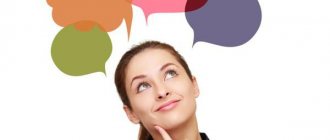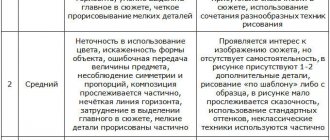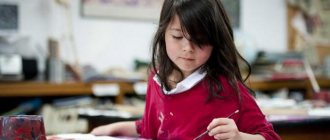Visual form of thinking in preschool age
In psychology, several forms of thinking are distinguished, most of which are formed in adulthood.
Before entering school, children go through the following mental stages:
- Clearly effective
- Visually figurative
- Theoretical
In the future, the formation of intuitive, analytical and empirical forms continues.
Visual types of thinking are most important for preschool age. It is the successful passage through these stages that provides the future adult with the ability to form judgments about events and draw conclusions.
Clearly effective
Visually effective thinking is fully formed at 3 years of age. Starting from the age of one and a half, boys and girls “think” with their hands.
The main features of visually effective thinking are the use of one’s own fingers as a tool of cognition.
Connecting broken halves, breaking or disassembling a toy - all this is a way of primary perception of objects and an opportunity to understand what surrounds a little person. That is why this type of cognition is called visually effective. Mastering an action—for example, stacking cubes—occurs after several successful attempts to assemble a turret or house.
Visually figurative
From about 3 years old, a new type of thinking begins to form: in addition to studying the world with one’s hands, a system of images imprinted in memory is added. This means that the baby can clearly reproduce an already familiar and memorized object. The skill of using an image is especially evident during drawing or sculpting.
Detailed image accuracy should not be expected at this age. The preschooler draws exactly those features that, in his opinion, characterize this or that object. The tree will have a trunk and branches. The house must be equipped with a roof and walls.
During this period, it is especially important for parents to encourage their child to engage in any activities related to visualization.
It could be:
- Application made of colored and shiny paper
- Games with construction kits
- Drawing with pencils, crayons, paints
- Modeling from clay and plasticine.
Thinking and mental operations
The ability to think is the main difference between a person and an animal. An animal lives by instincts, and a person is endowed with the ability to analyze. The ability to analyze what is happening and build connections between cognizable objects is called thinking.
Thinking is the individual ability to perceive reality. Each person has a mind, thanks to which certain patterns and interpretations are created in his head.
The thought process manifests itself in the form of several intellectual operations:
- comparison;
- analysis;
- synthesis;
- abstraction;
- specification;
- generalization;
- systematization.
There are four types of thinking:
- objective-effective;
- abstract-symbolic;
- visual-figurative;
- verbal-logical.
People with different types of thinking perceive the world around them differently and demonstrate their own reactions differently.
Features of thinking can be inherited or be the fruit of involuntary or purposeful upbringing.
In real life, it is quite rare to meet people with one type of thinking. Most often there is a dominant type, and the others appear less clearly and only when necessary.
How visually effective thinking develops in preschoolers
Supporting the development of visually effective and imaginative thinking in preschoolers is simple: the key goal of parents is not to interfere with the dismantling or “modernization” of objects. The only limitation is security measures. Materials should be as harmless as possible for younger preschoolers.
Object actions do not immediately lead the child to understand the main features and purpose of the object. It takes time and repeated manipulations for the child’s mind to grasp visual generalizations and build the necessary connections.
For example, if a preschooler made his first attempts to draw with a pencil, then when he sees colored crayons he will not imagine their purpose without preliminary tests.
It is especially effective to form the memory of images with the help of flowing and bulk materials. The child pours sand from hand to hand, makes slides from cereals, and pours water. Constant touching allows him to first determine and then remember that if the sand is properly crushed, it will turn out to be a Easter cake.
To summarize what has been said, the basic principle of the development of this form of thought process is expressed in repeated actions leading to the same result: a picture, an assembled toy, a sculpted figurine.
This is how the first ideas about specific objects and life experience arise, which lay the foundation for the development of mental forms.
Formation of visually imaginative thinking
The basis of visual figurative thinking is a guess about a possible result. Before taking an action, the child imagines the end result. For example, sitting at home, a preschooler is able to draw a picture of a car, remembering the one he liked on the street.
The first rudiments appear at 3 years. To evaluate the result, tactile contact with the object is no longer always necessary. The image in the head helps to correlate the object seen with an already known category and correctly evaluate it. A preschooler can easily recognize a doll or teddy bear on a display window without having to touch it first.
The greater the number of objects that are remembered, the less often tactile contact will be required for identification, but the connections and relationships between the image and the real object will be realized.
Why is it important to develop creative thinking?
The very concept of “image” means the imprinting of objects and phenomena of the real world in human consciousness, the formation of an imaginary appearance.
A preschooler, especially an older one, is already able to accumulate a sufficient number of such reflections. Moreover, sometimes they are not visual, but tactile or audio in nature.
The skill of imaginative thinking greatly simplifies a child’s interaction with the outside world. To solve a given problem, he just needs to imagine all its components and find the answer.
In the future, properly developed imaginative thinking will make it easier to master spatial thinking and imagine the world in three-dimensional display.
It is especially important to pay attention to the child at the stage of development of imaginative thinking for the following reasons:
- The ability to operate with images significantly speeds up the solution of first everyday, and later logical and mathematical problems;
- The ability to think in images forms the aesthetic component of the personality and the craving for beauty, which intensifies as one grows older;
- Operating with images contributes to the development of creative thinking.
Leading type of thinking
Senior preschool age is a period of 5-6 years. A unique time for a baby who absorbs information like a sponge. The leading type of thinking in children of senior preschool age is visual and figurative, but logical thinking is already beginning to take shape. The child becomes able to work with simple diagrams and tables, draw conclusions, find commonalities between objects, and can choose the correct answers in complex tasks.
Fiction and its reading in older groups - card index
The preschooler begins to think more and more, imagining objects; he no longer necessarily has to constantly see what is the subject of his thoughts. Thinking becomes more flexible, the frame that previously seemed to hinder development disappears. Prerequisites appear to explain this or that phenomenon, to determine the laws of the process.
It's important to understand. Children with mental retardation (MDD) may have lower intelligence compared to their peers, therefore, the teacher and, first of all, the parents are required to make great efforts in developing the child’s thinking.
Any developmental disorder that parents notice should not go unnoticed by a specialist, who, as a result of the examination, may indicate developmental delay. Such children need additional classes (art, rhythm, salt dough, design), which will be a good stimulus for development.
Ways to develop visually imaginative thinking
Depending on the age and preferences of the child himself, various methods are chosen, however, each is based on creating a result based on the presented image.
At the age of three, this is a game with a pyramid and similar collapsible toys. To begin with, the adult shows the process of disassembling and correctly assembling the toy, after which the child is asked to repeat the steps.
To complicate the task, you will need a pyramid with rings of various sizes. An additional effect of the toy is learning to highlight the essential properties of objects, distinguish between sizes, shapes, and shades. It can be stated that the process of developing imaginative thinking has begun when, before an action, the child is able to tell what he will now build or draw.
Basic methods applicable in older preschool age
In the future, the imaginative thinking of older preschoolers should be stimulated using the following methods and techniques:
- Observation of nature with subsequent descriptions and displays of what was seen;
- Comparative analysis of objects of various sizes and shapes;
- Collecting puzzles with gradual complication of the task;
- Drawing from memory;
- Creative work with plastic materials - modeling from clay, plasticine;
- Excursions to museums and exhibitions;
- Displaying on paper or canvas concepts that do not have visual signs: love, friendship, thought, sound, melody;
- Creating panels using natural materials, cardboard, colored paper.
The effectiveness of classes aimed at developing visual imaginative thinking in preschool age depends on the correct implementation of the stages of learning:
- Demonstration;
- Description or explanation;
- Cooperative activity;
- Independent work according to the sample;
- Creativity based on a generalization of ideas about a phenomenon, not limited by any framework.
Any activity should not tire the child. As soon as he feels tired, he needs to switch his attention to another activity. In addition, it is important to constantly encourage and motivate the child, cultivating in him a true passion for the process of drawing or constructive creativity.
Test with answers: “Thinking. Types of thinking"
I option.
1. The division of a complex object into its constituent parts or characteristics is: a) classification b) analysis + c) comparison
2. Cognitive ability, which determines a person’s readiness to assimilate and use knowledge and experience, as well as to behave rationally in problem situations, is: a) intelligence + b) thinking c) heuristics
3. Spearman developed this theory of intelligence: a) three-factor b) one-factor c) two-factor +
4. The ability to see and pose a new question, a new problem and then solve them on your own manifests such quality of thinking as: a) independence + b) speed c) breadth
5. The idea of quantitatively determining the intellectual development of children using tests belongs to: a) G. Eysenck b) J. Cattell c) A. Binet +
6. The type of thinking based on the direct perception of objects, real transformation in the process of actions with objects, is called the following thinking: a) abstract b) visual - real + c) verbal - logical
7. It is considered proven that the most recent product of the historical development of thinking is precisely this kind of thinking: a) visual - figurative b) visual - real c) verbal - logical +
8. Grouping of objects according to the similarity of the main features inherent in all objects of a given type is characterized as: a) classification + b) generalization c) abstraction
9. A form of thinking that identifies connections between objects or phenomena and affirms or denies something is called: a) inference b) concept c) judgment +
10. The central feature of pre-conceptual thinking (according to Piaget) is: a) logic b) egocentrism + c) use of concepts
11. Convergent and divergent thinking were identified by: a) Guilford + b) Piaget c) Godefroy
12. The mental unification of objects and phenomena according to their common and essential characteristics is known to us as: a) classification b) generalization + c) analysis
13. A person’s ability to put forward new problems and find ways to solve them without resorting to the help of other people is characterized by such quality of thinking as: a) independence + b) depth c) flexibility
14. The ability to penetrate into the essence of complex phenomena and processes manifests such quality of thinking as: a) breadth b) independence c) depth +
15. Theoretical and practical thinking are distinguished by: a) the type of problems being solved + b) the activity of the subject c) the nature of generalizations
16. Generality, abstraction, abstraction are essential characteristics of such thinking: a) visual - effective b) conceptual + c) practical
17. The psychological process associated with the search and discovery of new knowledge based on the creative reality of a person is called: a) attention b) ethics c) thinking +
18. The highest form of thinking: a) analysis b) inference + c) specification
19. The main feature of creative thinking: a) the ability to respond to internal and external actions b) the ability to extract the main thing c) the ability to analyze any problems, establish a logical connection +
20. What is necessary to solve a complex mental problem: a) solving the problem by solving previous ones b) skillfully choose solutions + c) concentrate
Option II.
1. Abstract - logical thinking is identical to: a) conceptual thinking + b) logical thinking c) practical thinking
2. Conceptual thinking is: a) thinking based on images b) using certain concepts + c) extracting images recreated by the imagination
3. What is a concept: a) activity carried out with real objects b) a type of mental process that is carried out directly during the perception of the surrounding reality c) reflection of the general and essential properties of objects or phenomena +
4. Generalization is: a) establishing similarities and differences between objects b) general conclusion of mental operations + c) separating the essential from the non-essential
5. Semantic spontaneous flexibility is: a) the ability to change the perception of an object b) the ability to see an object from a new angle c) the ability to produce different ideas in uncertain situations +
6. What is practical thinking? a) thinking, which consists of activity carried out by a real object b) thinking, associated with practical activity + c) thinking, when images are extracted from memory and imagination is recreated
7. Direct connection with the perception of surrounding reality is a distinctive feature of thinking: a) visual - figurative + b) verbal - logical c) inductive
8. Visual – imaginative thinking is clearly manifested at the age of: a) 7 – 8 years b) 9 – 10 years c) 4 – 6 years +
9. The fact that thinking unfolds under conditions of severe time shortage is one of the important features of thinking: a) practical + b) empirical c) analytical (logical)
10. A compressed, essentially unconscious act of momentarily “embracing” the structure of a situation or task is thinking: a) analytical b) intuitive + c) discursive
11. The name of the psychological process that is associated with the search and discovery of new knowledge based on the creative reality of a person? a) attention b) thinking+ c) ethics d) logic
12. What is the highest form of thinking called? a) specification b) analysis c) inference + d) concept
13. What is the main feature of creative thinking? a) the ability to extract the main thing b) the ability to respond to internal and external actions c) the individual’s inclination towards certain mental consciousnesses d) the ability to analyze any problems, establish a logical connection +
14. What is needed to solve a complex mental problem? a) concentrate b) solving a problem by solving previous difficult problems c) skillfully choose solutions + d) intelligence
15. Mental operations: a) generalization + b) concepts c) analysis + d) judgment
16. Which of the following are reasons that do NOT interfere with the manifestation of creative thinking? a) fear of seeming stupid or funny b) fear of criticizing others because of retaliation on their part c) overestimation of the importance of one’s own ideas + d) tendency to conformism
17. What type of thinking is based on a person’s perception of the surrounding reality? a) visual-figurative + b) practical c) verbal-logical d) visual-effective
18. Which of these options is classified as a method of producing inferences that reflect the direction of thought? a) induction + b) specification c) deduction + d) definition of concepts
19. Which of the following scientists studied the problem of intelligence? a) J. Piaget + b) I.P. Pavlov c) Z. Freud d) P.Ya. Galperin +
20. The main characteristics of human thinking: a) selectivity of reflection of reality b) reflection of significant connections and relationships + c) generalization and indirectness of reflection of reality + d) inextricable connection with speech +











